
The biennale of chief curator Gabi Ngcobo and her team –Nomaduma Rosa Masilela, Serubiri Moses, Thiago de Paula Souza and Yvette Mutumba- wasn’t built to be didactic, or to present art as a possible savior of todays society.
In July 2017 the curators of the X Berlin Biennale opened the event’s public program with a statement: I’m not who you think I’m not. The assertion served as a guiding point for the discourse to come, and responded to those who were certain what kind of biennale to expect from an all black curatorial team.
The double negative works like boxing’s rope-a-dope style in which the fighter leans on the ropes and uses them to dodge the opponent’s attack. When the rival is worn out they deliver the final punch. The biennale’s final strike is reflecting back society’s contours, and inviting it to look inwards: to become aware of the historic sediment words carry, to question why it feels entitled to read so much into a person’s race, and to reflect on why –as Hannah Arendt said- “the world [finds] nothing sacred in the abstract nakedness of being human.”
The biennale of chief curator Gabi Ngcobo and her team –Nomaduma Rosa Masilela, Serubiri Moses, Thiago de Paula Souza and Yvette Mutumba- wasn’t built to be didactic, or to present art as a possible savior of todays society. It wasn’t about redeemers at all, thus the title We don’t need another hero. It was –like Mario Pfeiffer’s movie Again shown in the Akademie der Künste- about showcasing different perspectives, and getting the public to reflect on society’s undercurrents of thought; and like Firelei Báez’ Sans-Souci installation –also at the Akademie- about unveiling hidden histories and embracing their complexities.
These are excerpts from an interview with German curator Yvette Mutumba and Brazilian curator Thiago de Paula Souza.
Cristina Esguerra: Throughout the process of curating the Berlin’s 10th biennale what lesson had the biggest impact on you?
Yvette Mutumba: To see how perceptions work. We all knew how new this would be, but one of the striking things that happened after who would curate the biennale was announced was how people reacted towards us. I don’t know if it was negative, but it was quite an experience. We were all taken aback by it, and it influenced our thinking.
C.E: Could you talk more about that?
Y.M: The public program is called I’m not what you think I’m not. That’s specifically saying there are certain expectations or perceptions of what we might do, and it’s a statement towards that. Saying: Things might be more complicated than you think. You can connect it to the fact that people tend to be simplistic and think, Well I know what they’re going to do because they have a certain background.
C.E: Why the double negative?
Thiago de Paula Souza: It’s more a game, a way to mock some people’s expectations or anxieties.
Y.M: It also balances out the negative. It’s a negation and it’s not a negation. It goes well with our thinking because we’re saying: We need to negate just to make a point but at the same time we’re not thinking negatively. It’s not only about saying no.
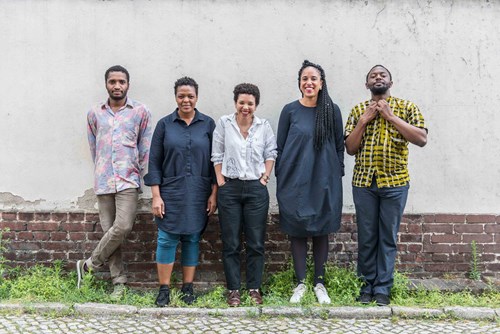
Curatorial team of the 10th Berlin Biennale for Contemporary Art, f. l. t. r.: Thiago de Paula Souza, Gabi Ngcobo, Nomaduma Rosa Masilela, Yvette Mutumba, Moses Serubiri, photo: F. Anthea Schaap
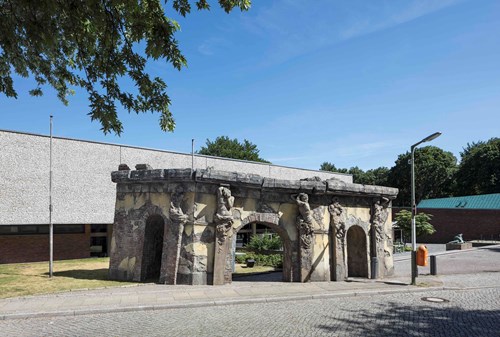
(Castle) Firelei Báez, 19° 36’ 16.89“ N, 72° 13’ 6.95“ W) / (52.4042° N, 13.0385° E, 2018, acrylic, sheetrock, steel, installation view, 10. Berlin Biennale, Akademie der Künste (Hanseatenweg), Berlin, courtesy Firelei Báez; Kavi Gupta Gallery, Chicago, photo: Timo Ohler
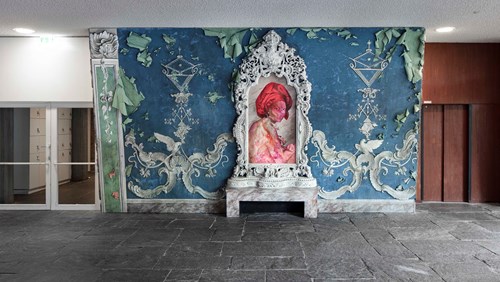
Firelei Báez, for Marie-Louise Coidavid, exiled, keeper of order, Anacaona, 2018, oil on canvas, installation view, 10. Berlin Biennale, Akademie der Künste (Hanseatenweg), Berlin, courtesy Firelei Báez; Kavi Gupta Gallery, Chicago, photo: Timo Ohler
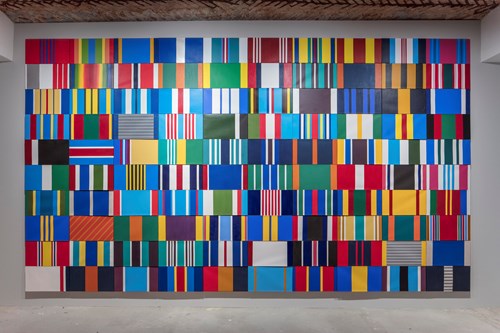
Lorrena Gutiérrez Camejo, ¿Dónde están los héroes? [Where are the heroes?], 2015–16, acrylic on canvas, 100 paintings, installation view, 10. Berlin Biennale, KW Institute for Contemporary Art, Berlin, courtesy Lorena Gutiérrez Camejo, photo: Timo Ohler
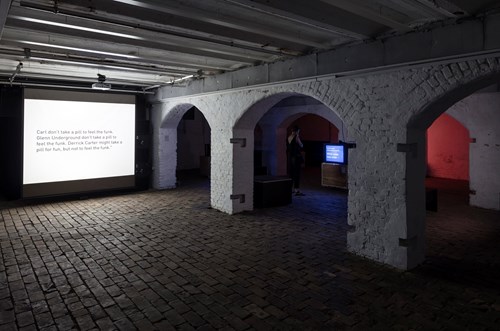
Tony Cokes, installation view, 10. Berlin Biennale, ZK/U Zentrum für Kunst und Urbanistik, Berlin, courtesy Tony Cokes; Greene Naftali, New York; Electronic Arts Intermix, New York, photo: Timo Ohler
C.E: For you personally, what would you like people to take away from the biennale?
Y.M: We didn’t have this one thing we said we wanted to be working towards because there’s the danger of becoming didactic. We said what we didn’t want to happen instead of raising our finger and being, Ok, look, this has to be like this or you can’t view the world like this and you have to understand our subjectivities.
It’s actually more interesting to see what happens. We talk a lot about subjectivity in our papers and it’s interesting to see how the subjectivities reflect back to us.
C.E: Is the exhibition what you imagined?
Y.M and T.P.S: Yes.
Y.M: It’s what we’ve been thinking about; how can we find a way to talk about these things that come up like power structures and knowledge systems. How can we question them and still not have crazy conceptual art that is complicated or only works with archival papers. We wanted to find other ways to make the point.
Often people expect something to be political. Everything is political, but to people it sometimes feels like a question of either or. It’s great to see how many of the artists in the show are managing to bring an aesthetic experience of the artwork, but if you want to dig deeper you discover all the other layers that come with it. Firelei Báez’ work is a good example.
C.E: Why did you publish the curatorial team’s brain storming in the biennale’s catalogue?
Y.M: We talk about our subjectivities so this was about being honest, about sharing our perspectives. That was one thing. But we talk a lot about accessibility and how to have a language that’s accessible. It would have been weird to address people in a statement. There was always the idea of transparency because it was never about being complicated or overly theoretical. It was about finding new ways of conversation, and to struggle figuring them out. It’s the realness that should come in.
C.E: Tell me about the public program.
T.P.S: The public program is a way to connect more with locals. It’s the possibility to keep moving and engaging people who are not necessarily this art crowd that comes for the opening and disappears.
Throughout the biennale we’ll have a series of events. For example, at Z/KU [Center for Arts and Urbanistics] we’ll have Speise Kinos that are films and foods. There we will also have Dance to my dreams where Tony Cokes’ installation [Remix No.1] is. It’ll be like club evenings that will be in dialogue with Cokes’ installation. We’re inviting DJ’s who will activate the space in a different way. Techno music is perceived in Berlin as being whitewashed. Cokes’ production questions us: What happened to that club culture in the US that once it arrived in Europe became hedonistic, and it’s no more about struggle? It’s not moralistic. It just wanders what happened.
C.E: How did you work with the artists?
Y.M: We never gave them any sort of framework. We didn’t even tell them the title until it was announced. It was about meeting them, and talking to them about what we are thinking. We had these key molds, as we call them, which were power structures, and the narratives with which we can question them…etc. From that they would start developing their work. But it wasn’t a commission that we would say: We’re doing a show titled We don’t need another hero, what do you think? So we didn’t really know what the outcome would be.
T.P.S: There was this moment with Lorena Gutierrez when we were in Habana. We didn’t meet her but we saw her work Dónde están los heroes [Where are the heroes?], which is at KW. Since the beginning we said, Oh let’s have this. We’d already started discussing the title so we got interested in having a piece that is in very strong dialogue with it. But if you look at the piece without reading the name you don’t necessarily notice that.

ArtDependence Magazine is an international magazine covering all spheres of contemporary art, as well as modern and classical art.
ArtDependence features the latest art news, highlighting interviews with today’s most influential artists, galleries, curators, collectors, fair directors and individuals at the axis of the arts.
The magazine also covers series of articles and reviews on critical art events, new publications and other foremost happenings in the art world.
If you would like to submit events or editorial content to ArtDependence Magazine, please feel free to reach the magazine via the contact page.